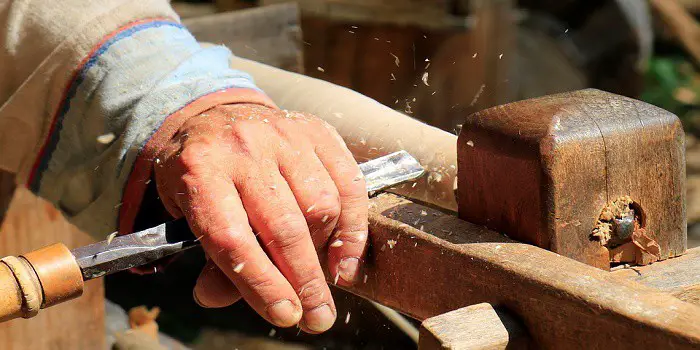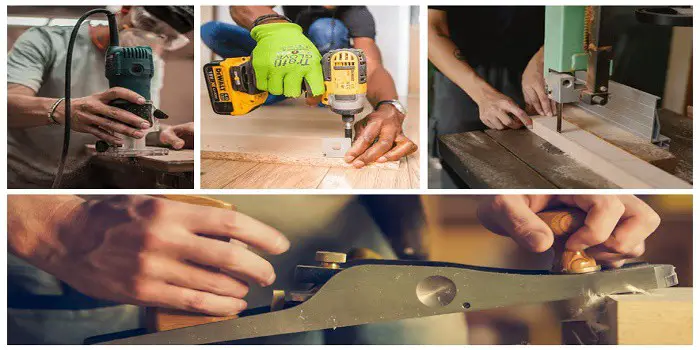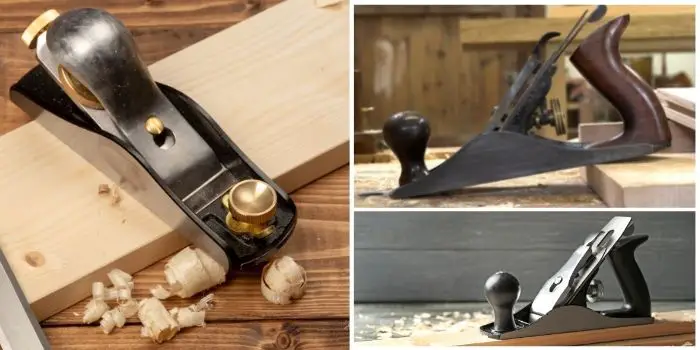
Although similar in some ways, the block plane and the bench plane are two different types of woodworking planes.
They are quite common and used by carpenters, woodworkers, and those who design their own projects.
The main difference between a block plane and a bench plane is that block planes are smaller and have a bevel facing upwards, while bench planes are larger and have a bevel facing downwards.
A block plane is basically a small hand plane designed to smooth end grain and boards with irregular shapes. A bench plane is a larger hand plane designed for taking heavy shavings on longboards.
Because of their differences, knowing which one to use on your project should be based on the purpose of the block or bench plane.
What you will see in this article is the other major differences between the block plane and the bench plane.
Armed with this information, you can make the best-informed decision about which one to use for your project.
Block Plane vs. Bench Plane – Difference
The first noticeable distinction between the bench plane and block plane is in their beveled face.
For block planes, the bevel is facing up, while on bench planes, the cutting bevel is facing down.
The other variation is in the materials they are made up of. While block planes tend to be made from softer metals such as brass or copper, bench planes are mostly made out of steel.
A few other major differences between both these wood planes include:
1- The Size
Block planes tend to be smaller, with most limited to a length of 6” or 7”. This makes them easy to store and also use with one hand.
Bench planes come in different sizes but tend to be longer. The sizes are denoted by a numbering system that ranges from 1 to 8.
Smoothing planers are numbered from 4 to 4 ½ and may range up to 10” in length.
Jack planes are numbered from 5 to 5 ¼ and may range from 11” to 15”, although the most popular is 14”.
Jointer planes are the longest and are numbered from 7 to 8. They tend to be from 22” up to 30” in length. Other differences include the following.
2- The Blade
The block plane generally has a blade length of 1” to 2” that is mounted on the end of the body.
You can set the blade vertically and from any location from the top to the bottom. Most block planes are set about 3/8” above the sole.
Bench planes have a blade that ranges from 1 ½” to 5” wide and from 2 ½” to 8” long, depending on their use.
You can adjust the mouth opening along with the depth of the blade. The blade can be adjusted to several different positions by using a wrench or screwdriver.
3- The Blade Angle
Apart from their respective sizes, the most noticeable difference between block and bench planes are the angles at which their blades are set.
Block planes have blades set at roughly 20-degree angles, while bench planes have blade angles up to 45 degrees. This makes block planes well-suited for trimming and shaving off wood pieces. In contrast, bench planes may tend to gouge the wood fibers.
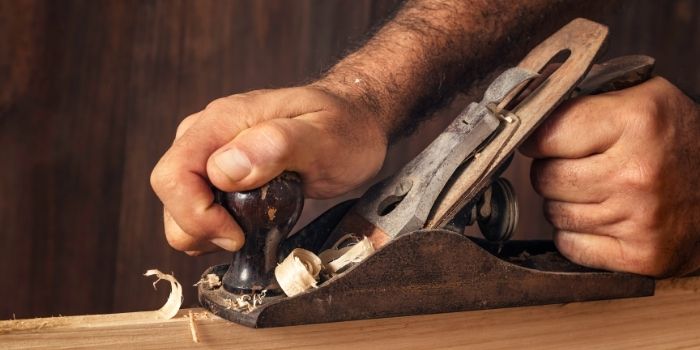
Basic Uses of Block Plane and Bench Plane
A typical block plane is best suited for tight areas that are too small or restricted for a hand planner to move about.
Block planes tend to be compact and are primarily used for making blocks and boards.
Those who use a block plane are generally removing stock or smoothing surfaces.
1- Smoothing:
Because the block plane is crafted from heavy materials such as iron, it can go through wood fibers quickly and easily.
For hardwoods that have been cut by a saw, a block plane is exceptional for its ability to smooth the edges quickly and easily.
It’s also well-suited for softer woods, particularly pine, as the resin and pitch from that wood do not build up in the blades.
A block plane is also a great tool for
2- Flush Trimming:
You can trim down the edges where boards meet.
Plus, the block plane can quickly trim flush surfaces so you can join wood together tightly.
The block plane will leave the joint looking clean, neat, and attractive while also being nearly invisible to the naked eye.
One greatest advantages of a block plane is that you can use the cutting end to shape boards and other surfaces of wood. This means foregoing the larger bench plane.
Uses of Bench Plane
For those who love woodworking, the bench plane is also one of the essential tools on the market.
You can use it for a wide variety of tasks that include the following.
- Cabinetry
- Timber Framing
- Joinery Work
- Creating Caskets and More
You can find bench planes in different sizes, but the main difference between them and block planes is the weight.
Because bench planes are heavier, they can remove material faster.
This means that you can use them in a more aggressive fashion compared to a block plane.
Plus, they are easier to handle because of the tote and knob that provides your hands a place to hold the tool comfortably.
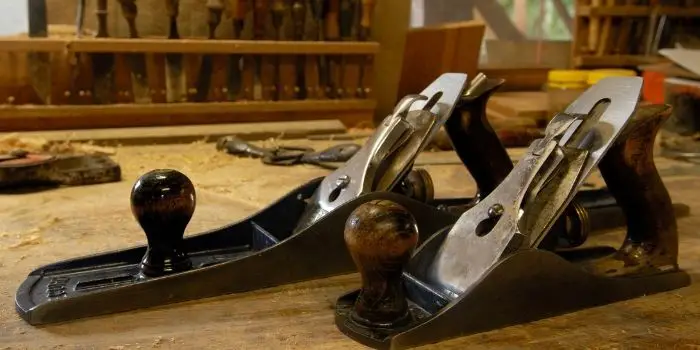
Different Types of Bench Planes and Block Planes
There are three basic types of bench planes, jack, joiner, and smoothing.
All three planes are general purpose in nature so they can be used for a wide variety of tasks in the workshop.
a) Jack bench plane
The jack plane is quite versatile and crafted from high-quality materials.
The name is quite appropriate as this is a “jack of all trades” type of plane.
From beginners to skilled woodworkers, use this plane as a replacement for the jointer and a smoother plane if needed.
There are two versions of the jack plane, standard and low angle.
You can use the jack plane to remove a considerable amount of material quickly. Plus, it can smooth out surfaces fast.
Because of its relatively short length, it is easier to handle compared to the other two versions of bench planes.
b) Jointer bench plane
The jointer plane is mostly used to create flat boards, trim doors and cabinets, and other jobs that require trimming away excess material.
This type of plane is also known as a jointing or fore plane.
The jointer plane achieves its goal by taking away small shavings of wood for every stroke.
It is ideal for straightening out lumber that is rough so that other work can be performed.
c) Smoothing bench plane
As the name suggests, this is a plane primarily designed to smooth wood surfaces. The goal is to produce a fine finish so the wood can be used for other purposes.
A smoothing plane is rather large, with a long body and two handles for easy handling.
The handles are perpendicular to the body which makes it easy to smooth out larger surfaces.
Types of Block Plane
There are three basic types of block planes.
They are low-angle, shoulder, and standard. Each one has a particular niche in which it excels.
a) Low Angle block plane
As its name suggests, this block plane is distinguishable thanks to how it looks.
The primary use of the low-angle block plane is to smooth out rough surfaces before they are glued together.
Of course, you can also create bevels and place chamfers on the edges with this tool.
On occasion, this type of block plane replaces a chisel or other cutting instrument for those who want a specific result.
You can adjust the mouth to an open or closed throat. Plus, you can also perform a square iron cut.
The angle of the blade is determined by its configuration relative to how the block plane sits on the surface.
The angle of this block plane tends to be around 12 degrees, although that can be adjusted. Keep in mind that there are no chip breakers with this tool.
b) Standard block plane
This tool is mostly used with one hand to shape surfaces. You can also create bevels, chamfers, and rabbits.
The blade is fixed at 20 degrees and is mostly suited for general carpentry and woodworking when you need to smooth out wood surfaces or shape them in a particular way.
c) Shoulder block plane
This is called the shoulder plane because when it is used, the tool is held vertically to the body with the knife on the stock surface.
The blade is designed to shave off thin slices of wood. This plane is also known as a dead, fill, or rabbet plane.
The shoulder plane is used to fine-tune joints and joinery, such as tenons, rabbets, dovetails, and dados.
Final Thoughts – what to choose between the block and bench planes
IMO, of all the planes, the block plane is arguably the most versatile.
This is because you can use it for cross-grain, finishing end grains, jointing, chamfering, or across the width of the board.
But bench planes do have their benefits as well and are great for certain tasks.
So, in the end, it comes down to your work requirement and the style of working.
You can either choose both of them or the one that is best suited based on your specific project type.
Share the post "Block Plane vs. Bench Plane – What are the Differences?"

Hi, I am Mark Garner a professional carpenter, woodworker, and DIY painter. I live in the small city of Peoria, Arizona as a semi-retired woodworker. I have started this blog with a simple motive to help you with my wood experience in this sector. If you like to know more about what I love doing and how it all got started, you can check more about me here.


